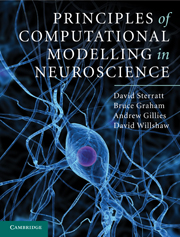Book contents
- Frontmatter
- Contents
- List of abbreviations
- Preface
- Acknowledgements
- Chapter 1 Introduction
- Chapter 2 The basis of electrical activity in the neuron
- Chapter 3 The Hodgkin–Huxley model of the action potential
- Chapter 4 Compartmental models
- Chapter 5 Models of active ion channels
- Chapter 6 Intracellular mechanisms
- Chapter 7 The synapse
- Chapter 8 Simplified models of neurons
- Chapter 9 Networks of neurons
- Chapter 10 The development of the nervous system
- Chapter 11 Farewell
- Appendix A Resources
- Appendix B Mathematical methods
- References
- Index
Chapter 7 - The synapse
- Frontmatter
- Contents
- List of abbreviations
- Preface
- Acknowledgements
- Chapter 1 Introduction
- Chapter 2 The basis of electrical activity in the neuron
- Chapter 3 The Hodgkin–Huxley model of the action potential
- Chapter 4 Compartmental models
- Chapter 5 Models of active ion channels
- Chapter 6 Intracellular mechanisms
- Chapter 7 The synapse
- Chapter 8 Simplified models of neurons
- Chapter 9 Networks of neurons
- Chapter 10 The development of the nervous system
- Chapter 11 Farewell
- Appendix A Resources
- Appendix B Mathematical methods
- References
- Index
Summary
This chapter covers a spectrum of models for both chemical and electrical synapses. Different levels of detail are delineated in terms of model complexity and suitability for different situations. These range from empirical models of voltage waveforms to more detailed kinetic schemes, and to complex stochastic models, including vesicle recycling and release. Simple static models that produce the same postsynaptic response for every presynaptic action potential are compared with more realistic models incorporating short-term dynamics that produce facilitation and depression of the postsynaptic response. Different postsynaptic receptor mediated excitatory and inhibitory chemical synapses are described. Electrical connections formed by gap junctions are considered.
Synaptic input
So far we have considered neuronal inputs in the form of electrical stimulation via an electrode, as in an electrophysiological experiment. Many neuronal modelling endeavours start by trying to reproduce the electrical activity seen in particular experiments. However, once a model is established on the basis of such experimental data, it is often desired to explore the model in settings that are not reproducible in an experiment. For example, how does the complex model neuron respond to patterns of synaptic input? How does a model network of neurons function? What sort of activity patterns can a network produce? These questions, and many others besides, require us to be able to model synaptic input. We discuss chemical synapses in most detail as they are the principal mediators of targeted neuronal communication. Electrical synapses are discussed in Section 7.7.
Information
- Type
- Chapter
- Information
- Principles of Computational Modelling in Neuroscience , pp. 172 - 195Publisher: Cambridge University PressPrint publication year: 2011
Accessibility standard: Unknown
Why this information is here
This section outlines the accessibility features of this content - including support for screen readers, full keyboard navigation and high-contrast display options. This may not be relevant for you.Accessibility Information
- 2
- Cited by
